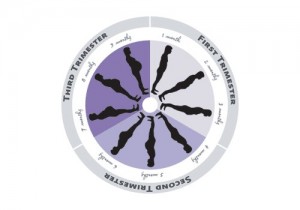Fertile days calculator
The calculator calculates the fertile days according to the Ogino-Knaus method. It is about this, that the day of ovulation for the next cycle and the date of the next menstruation are determined based on the course of previous monthly cycles. Unfortunately, the Ogino-Knaus method assumes, that a woman's monthly cycle is always smooth and regular, that is, menstruation occurs after a certain number of days, for example always what 28 or 31 days.
Fertile days calculator

Thus, the calculator can only indicate fertile days with a greater or lesser probability. The Ogino-Knaus method used in the fertile day calculators takes into account the fact, that ovulation always occurs on 14 days before your next period. Additionally, the calculator also takes into account the lifetime of the egg and sperm cells, what causes, that the calculator shows the fertile days as a period of roughly seven to eight days - the egg can live 24 do 48 hours, and the sperm live about 72 hours.
Calculating fertile days with a calculator can be used as a method of pregnancy prevention, however, it should not be called contraception, because as defined by the World Health Organization, only these methods can be called contraception, which prevent conception without sexual abstinence. The Ogino-Knaus method, and therefore fertile day calculators, are considered natural methods of family planning.
Fertile days calculator - action
To perform the calculations, the calculator will need to enter the length of the monthly cycle and the date of the last period. The accuracy of the fertile days calculator is not affected by the length of the cycle, but just its regularity. Variations of a day or two are not very serious yet, but already in a situation, when the lengths of the individual cycles differ by more than three days, the calculator's indications will be less precise and the hypothetical fertile period according to the calculator's indications may last more than ten days. Basically you can say, that in women who menstruate regularly, fertile days are between 8 a 17 day of the cycle for 28-day cycles - the longer the monthly cycle, this day the fertile days move another day forward, so with a 31-day cycle, your fertile days will fall on 11-20 day of the cycle, while shifting the infertile days.

Fertile days calculator - what else is worth knowing
Good to remember, that fertile days are not always halfway through the cycle, but they do depend on the length of your periods between consecutive periods. The calculator calculates the first day of the fertile phase by subtracting 20 days from the total number of days of the cycle, therefore, in a 26-day cycle, the beginning of fertile days falls on 6 day of the cycle, and in a 31-day cycle on 11 the day after the first day of menstruation. The end of the fertile phase is 11 the day before the end of the cycle, so on a 26-day cycle it will be this 15 day of the cycle, and on a 31-day cycle, the end of the fertile phase will be at 20 day of the cycle. When the monthly cycles are of different lengths, 20 days are subtracted from the shortest cycle, while the end of the fertile period is calculated by subtracting 11 days from the number of days of the longest cycle. Unfortunately, in practice, various factors may affect the reliability of the calculation of fertile and infertile days, such as lack of sleep, stress, infection, disease, alcohol abuse, irregular lifestyle, change of climatic or time zone.
As a method of pregnancy prevention, fertile day calculators are among the least effective - the Pearl Index for this method fluctuates between 14-40 points (for comparison, hormone pills or IUDs have a Pearl Index of less than 1). The Ogino-Knaus method, which the fertile days are calculated, it is worth combining with other natural methods, which will increase its effectiveness. This could be, for example, a thermal method (measuring the body temperature of a woman), observation of the cervical mucus, soreness around the lower abdomen and breast signaling ovulation or a marriage calendar. The calculator that calculates the fertile days may also prove ineffective for these women, who do not have a permanent sexual partner and enjoy spontaneous sex, women leading a fairly irregular lifestyle (staying up all night, shift work, trouble falling asleep, stressful job or personal situation, caring for a small child requiring frequent waking up at night), breastfeeding women and women, which have completed 40 years, because ovulatory fluctuations often happen before menopause.
Article found through the following phrases:
- fertile days calculator
- fertile days calendar
- fertility calculator
- fertile days
- fertile days-calculator
- calculator of fertile and infertile days
- fertile days calculator irregular period
- female calculator without specifying the cycle length
- cycle calculator
- fertility calculator